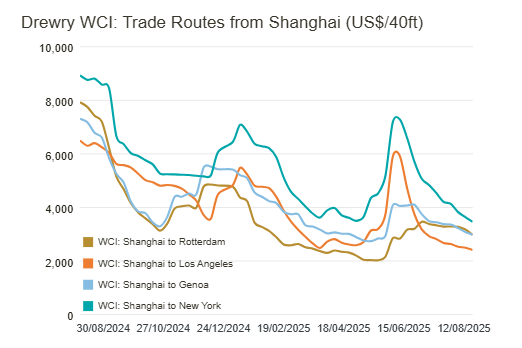
Asia-USWC container rates nearing pre-Red Sea diversion levels
LONDON: Rates for shipping containers from east Asia and China to the US continued to fall this week, with rates to the US West Coast nearing where they were when carriers began avoiding the Red Sea because of attacks by Houthi rebels.
The sudden move to avoid the Red Sea and Suez Canal in November 2023 forced carriers to use the much longer route around the southern tip of the African continent and sent rates soaring because the longer voyage tightened capacity.

Rates to the USWC from supply chain advisors Drewry fell by 3% this week, as shown in the following chart, and are now just about $75/FEU (40-foot equivalent unit) higher than in November 2023.
Container rates continue to fall as transpacific trade is experiencing a weak peak season after many retailers pulled forward volumes to get ahead of US tariffs, and capacity is ample even as carriers use blank sailings and other tools in efforts to support the falling rates.
Drewry expects rates to be less volatile in the coming weeks as shippers respond to a decelerating US economy and increased tariff costs by scaling back on procurement.
Drewry is still forecasting rates to fall further in the second half of the year as it anticipates the supply-demand balance to weaken further.
Rates from online freight shipping marketplace and platform provider Freightos fell by 8% to the West Coast and are about $140/FEU from where they were in November 2023.
Judah Levine, head of research at Freightos, said daily rates are level with where they were at the start of the Red Sea crisis.
The SCFI Shanghai-USWC rate fell 4% week on week to $1,759/FEU and is now down 69% since 1 June amid sluggish peak season demand, despite carrier efforts to curb capacity on the route.
Container ships and costs for shipping containers are relevant to the chemical industry because while most chemicals are liquids and are shipped in tankers, container ships transport polymers, such as polyethylene (PE) and polypropylene (PP), are shipped in pellets. Titanium dioxide (TiO2) is also shipped in containers.
They also transport liquid chemicals in isotanks.
LIQUID TANKER RATES STEADY-TO-LOWER
US chemical tanker freight rates assessed by ICIS were steady lower this week with rates on the transatlantic route edging lower on the high side as most trade lanes are facing downward pressure.
The route to NW Europe remains relatively inactive and a tighter position list has kept the rates firm. Several market participants were seen quoting styrene and methanol to the region. There have only been a few cargos fixed.
There continues to be downward pressure on rates along the USG-Asia trade lane as charterers are still in wait-and-see mode. Besides COA (contract) cargo there is very little seen in the market. Also, there are very few new spot enquiries, therefore the shorter tonnage list supports the rates. The usual spot cargoes of methanol from Jose to China are the only ones reported, leaving methanol requirements from the region active to Asia.
From the USG to Brazil, this trade lane remains unusually quiet and in turn rates seem to have steadied. Fewer fixtures were noted this week, and the lack of prompt availability seems to indicate supply is somewhat tight and therefore owners appear to be cautious about letting rates decline any further.
The USG to India route has not seen an uptick in inquiries over the last week with no confirmed fixtures, leading to lower rates along this trade lane. There was only one new inquiry for September dates. Along with the other regions, freight rates are widely viewed as softer.
Source: ICIS
